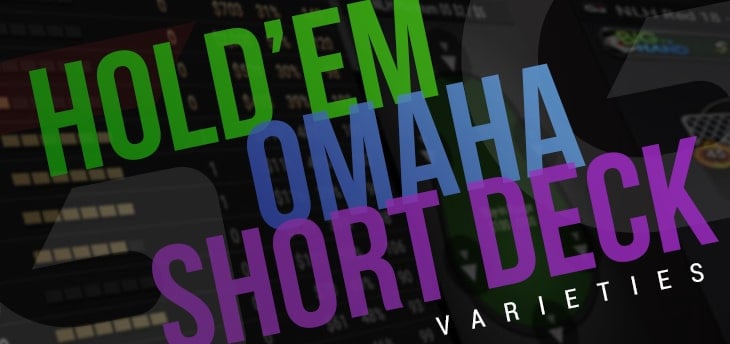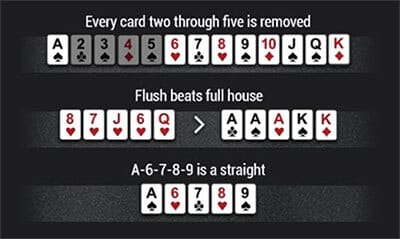The Beginners Guide Series: A Primer for Hold’em, Omaha and Short Deck

It’s often said that “variety is the spice of life,” and poker is a game that embraces and strives to exemplify this. Many versions of poker share the same core mechanics, but come packaged with novelties that change the dynamics of the game and the strategies you’ll need to use.
This diversity is a benefit to poker. It ensures the game is infinitely replayable and that every game is different. If you find a particular format monotonous after a while, you have the freedom to mix things up and try another one. The variety ensures that poker has a broad appeal, as each person can try all kinds of poker until they find the way they like to play.
In this article, we’ll be providing an overview of three of the most popular poker games and covering the basics for each one. We’ll also look at some of the strengths and weaknesses of the different games to help you decide which one you’d like to try next.
The Most Popular Way to Play: Texas Hold’em
If you have ever caught a broadcast of The World Series of Poker, there’s a good chance you’ve seen the pros playing Texas Holdem.
Texas Holdem is by far the most popular poker variant in the world today. It is most people’s first introduction to poker games and is the best option for beginners. It’s easy to teach and takes minutes to learn. Yet, there is enough strategic depth which can take years to appreciate and even longer to master.
Overview:
Every player is dealt two hole cards at the start of the game, and five more shared community cards will be dealt to the middle of the table in three phases. The goal of the game is to make the best poker hand possible by using any combination of the hole cards and the community cards.
Most forms of Texas Holdem start with a form of ante called “blinds” to ensure money is always in the pot and discourage hyper-conservative play. At the start of the game, one player is given “the button”, designating them as the dealer for the round. Positions will rotate clockwise after every hand. The two players to the dealer’s left are designated small blind and the big blind, both of whom must make forced bets before any cards are dealt. The big blind antes a set amount depending on the game’s stakes, and the small blind adds half this amount to the pot. After the blinds are paid, the play begins with the action starting with the player to the left of the big blind.

The Flow of a Hand:
Two cards are dealt to each player. These are the players’ hole cards and which only they can use. We’re now in the pre-flop, when the first round of betting takes place.
During betting rounds, players have five choices. If no previous bet has been made, a player can ‘check’ to stay in the hand and pass play onto the next player. If there is a bet, which includes an unmatched blind, a player can ‘call’ to match the bet and stay in the hand. A ‘bet’ is to put money into the pot while a ‘raise’ is to match a previous bet and put additional chips into the pot. A raise has to be the equal to, or more than the previous bet. Finally, a player can ‘fold’ their hand if they no longer want to participate in the hand. Any previous chips they have committed are lost to the pot and they are out of the action until the next hand.
There are a total of four betting rounds in a hand of Texas Holdem. ‘Pre-flop’ betting occurs after the hole cards are dealt, but before the flop. Three cards are dealt out on ‘the flop’, and the second betting round occurs. One card is dealt for the ‘turn’ for the third betting round, then finally a card is dealt on ‘the river’, after which, the final betting round takes place.
If there are two or more players left in the hand after the last betting round on the river, the showdown occurs. Players reveal their hands and the best hand wins. In the case of a tie, the pot is split as evenly as possible. If there is an extra poker chip, it goes to the first player who is still in the hand to the left of the dealer
Even if you find that Texas Holdem is not the right game for you, the mechanics are similar enough to many other poker games that it provides a solid foundation on which to build your knowledge of other poker variants.

Bigger Hands, Bigger Pots: Omaha
Omaha poker is the world’s second most popular form of poker. It is similar to Texas Holdem in many ways, but differs in the number of hole cards you receive and in the number of cards you can use to build a hand.
The game is more draw-focused, requiring you to play tighter since it’s always possible that someone has a more substantial hand. The Pot Limit betting format also shifts Omaha from an aggressive game of deception to a more tactical game of odds and draws. These differences lead to Omaha players to have a wildly different strategy from Holdem.
Omaha Poker shares nearly all its mechanics with Texas Holdem except for a few major differences. Players start the game with four hole cards instead of two. You must use exactly two of your hole cards and three community cards to make your hand, unlike Holdem, where you can use any amount of either. If you’re dealt four Aces, they’re not nearly as good as they look, since you can only use two of the aces and since you have the other two, it means they will not show up in the community cards either. Four hole cards makes Omaha a tighter game preflop than Holdem, as there are fewer situations where you are guaranteed the best hand. Four hole cards mean more draw potential for everyone, so relative hand strength can fluctuate wildly.
Games of Omaha can be found using betting structures as varied as Texas Holdem, but Omaha is played more often as Pot-Limit, so players can only bet or raise equal to the current size of the pot. This limits the number of chips that can be won or lost in a single hand, making it harder to pull off some of the deceptive moves and daring bluffs seen in No-Limit Holdem. With Pot-Limit, it’s much more difficult to force someone to fold with a big bet, making the games more tactical.

Bigger and Faster: 6+ Short Deck
Finally, the last form of poker here is Short Deck. The mechanics are nearly identical to Texas Holdem, with the primary change of the game being the truncated 36-card deck Every card from two to five has been removed. This makes all hands closer in strength and there is a shift in the hand rankings, as the odds of getting a flush is lower, thus it becomes more powerful than a full house. An Ace-6-7-8-9 now counts as a straight.
Short Deck is commonly played using antes instead of blinds. Everyone at the table has to pay each round to play in the hand. The player in the dealer button also pays an additional ante to compensate for the advantage of position. While very similar to regular Holdem, Short Deck is quickly becoming popular for those looking for a thrilling, faster-paced game. These small changes lead to faster-paced games with bigger hands.
There we have it; an overview of three of the most popular variations of the game to get you started into the world of poker. We hope this beginner’s guide helped you to understand just a little bit more about the various forms of one of the world’s most popular pastimes.
